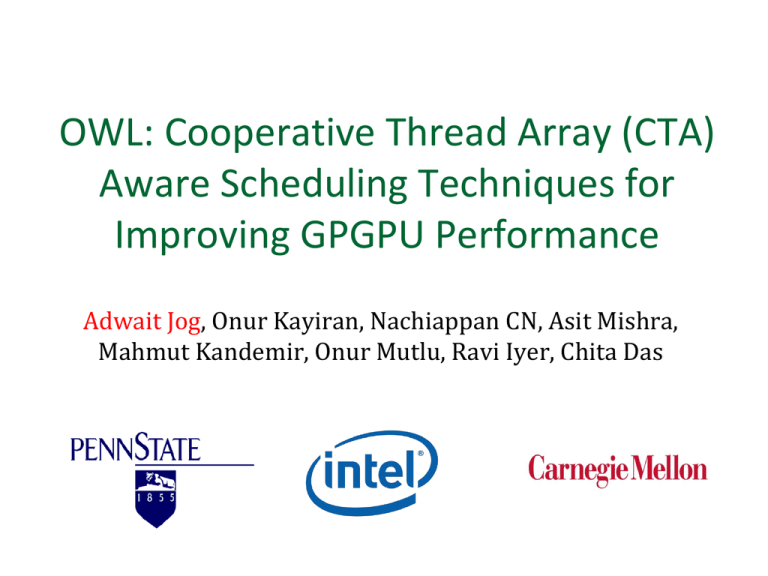Slides
advertisement

OWL: Cooperative Thread Array (CTA) Aware Scheduling Techniques for Improving GPGPU Performance Adwait Jog, Onur Kayiran, Nachiappan CN, Asit Mishra, Mahmut Kandemir, Onur Mutlu, Ravi Iyer, Chita Das Super Computers Desktops Laptops Smartphones Tablets Gaming Consoles GPUs are everywhere! Source: nVIDIA Executive Summary Limited DRAM bandwidth is a critical performance bottleneck Thousands of concurrently executing threads on a GPU May not always be enough to hide long memory latencies Access small size caches High cache contention Proposal: A comprehensive scheduling policy, which Reduces Cache Miss Rates Improves DRAM Bandwidth Improves Latency Hiding Capability of GPUs 3 Off-chip Bandwidth is Critical! AVG: 32% 55% 100% 80% 60% Type-1 Applications Type-2 Applications 40% AVG AVG-T1 0% SAD PVC SSC BFS MUM CFD KMN SCP FWT IIX SPMV JPEG BFSR SC FFT SD2 WP PVR BP CON AES SD1 BLK HS SLA DN LPS NN PFN LYTE LUD MM STO CP NQU CUTP HW TPAF 20% GPGPU Applications Percentage of total execution cycles wasted waiting for the data to come back from DRAM 4 Outline Introduction Background CTA-Aware Scheduling Policy 1. Reduces cache miss rates 2. Improves DRAM Bandwidth Evaluation Results and Conclusions 5 High-Level View of a GPU Threads SIMT Cores W CTA W CTA W W CTA W CTA W Scheduler L1 Caches Warps ALUs Interconnect Cooperative Thread Arrays (CTAs) L2 cache DRAM 6 CTA-Assignment Policy (Example) Multi-threaded CUDA Kernel CTA-1 CTA-2 SIMT Core-1 CTA-1 CTA-3 Warp Scheduler L1 Caches ALUs CTA-3 CTA-4 SIMT Core-2 CTA-2 CTA-4 Warp Scheduler L1 Caches ALUs 7 Warp Scheduling Policy All launched warps on a SIMT core have equal priority Round-Robin execution Problem: Many warps stall at long latency operations roughly at the same time Send Memory Requests CTA CTA CTA CTA CTA CTA CTA CTA W W W W W W W W W W W W W W W W All warps have equal priority All warps compute SIMT Core Stalls All warps have equal priority All warps compute Time 8 Solution Send Memory Requests CTA CTA CTA CTA CTA CTA CTA CTA W W W W W W W W W W W W W W W W SIMT Core Stalls All warps have equal priority All warps have equal priority All warps compute All warps compute CTA W W CTA Send Memory Requests W W CTA CTA W W W W • Form Warp-Groups (Narasiman MICRO’11) • CTA-Aware grouping • Group Switch is Round-Robin CTA CTA W W W W CTA W W CTA Saved Cycles W W Time 9 Outline Introduction Background CTA-Aware Scheduling Policy "OWL" 1. Reduces cache miss rates 2. Improves DRAM bandwidth Evaluation Results and Conclusions 10 OWL Philosophy (1) OWL focuses on "one work (group) at a time" 11 OWL Philosophy (1) What does OWL do? Selects a group (Finds food) Always prioritizes it (Focuses on food) Group switch is NOT round-robin Benefits: Lesser Cache Contention Latency hiding benefits via grouping are still present 12 Objective 1: Improve Cache Hit Rates Data for CTA1 arrives. No switching. CTA 1 CTA 3 CTA 5 CTA 7 CTA 1 CTA 3 CTA 5 CTA 7 CTA 3 CTA 5 CTA 7 Data for CTA1 arrives. Switch to CTA1. CTA 1 CTA 3 C5 CTA 1 C5 CTA 7 No Switching: 4 CTAs in Time T T Switching: 3 CTAs in Time T Fewer CTAs accessing the cache concurrently Less cache contention Time 13 Reduction in L1 Miss Rates Normalized L1 Miss Rates Round-Robin CTA-Grouping CTA-Grouping-Prioritization 1.20 1.00 0.80 8% 0.60 18% 0.40 0.20 0.00 SAD SSC BFS KMN IIX SPMV BFSR Limited benefits for cache insensitive applications Additional analysis in the paper. AVG. 14 Outline Introduction Background CTA-Aware Scheduling Policy "OWL" 1. Reduces cache miss rates 2. Improves DRAM bandwidth (via enhancing bank-level parallelism and row buffer locality) Evaluation Results and Conclusions 15 More Background Independent execution property of CTAs CTAs can execute and finish in any order CTA DRAM Data Layout Consecutive CTAs (in turn warps) can have good spatial locality (more details to follow) 16 CTA Data Layout (A Simple Example) Data Matrix A(0,0) A(0,1) CTA 1 A(0,2) A(0,3) mapped to Bank 1 CTA 2 A(1,0) A(1,1) A(1,2) A(1,3) mapped to Bank 2 A(2,0) A(2,1) A(2,2) A(2,3) mapped to Bank 3 CTA 3 A(3,0) A(3,1) CTA 4 A(3,2) A(3,3) mapped to Bank 4 DRAM Data Layout (Row Major) Bank 1 Bank 2 Bank 3 A(2,0) A(2,1) A(2,2) A(2,3) Bank 4 Average percentage of consecutive CTAs (out of total CTAs) accessing the same row = 64% A(0,0) A(0,1) A(0,2) A(0,3) A(1,0) A(1,1) A(1,2) A(1,3) A(3,0) A(3,1) A(3,2) A(3,3) : : : : : : : : 17 Implications of high CTA-row sharing SIMT Core-2 SIMT Core-1 CTA-1 CTA-3 CTA-2 CTA-4 W W W W W W W W CTA Prioritization Order CTA Prioritization Order L2 Cache Idle Banks Row-1 Row-2 Row-3 Row-4 Bank-1 Bank-2 Bank-3 Bank-4 18 Analogy Which counter will you prefer? THOSE WHO HAVE TIME: STAND IN LINE HERE Counter 1 THOSE WHO DON’T HAVE TIME: STAND IN LINE HERE Counter 2 Which counter will you prefer? THOSE WHO HAVE TIME: STAND IN LINE HERE Counter 1 THOSE WHO DON’T HAVE TIME: STAND IN LINE HERE Counter 2 Lower Row Locality Higher Bank Level Parallelism High Row Locality Low Bank Level Parallelism Bank-1 Bank-2 Bank-1 Bank-2 Row-1 Row-2 Row-1 Row-2 Req Req Req Req Req Req Req Req Req Req Req OWL Philosophy (2) What does OWL do now? Intelligently selects a group (Intelligently finds food) Always prioritizes it (Focuses on food) OWL selects non-consecutive CTAs across cores Attempts to access as many DRAM banks as possible. Benefits: Improves bank level parallelism Latency hiding and cache hit rates benefits are still preserved 22 Objective 2: Improving Bank Level Parallelism SIMT Core-1 SIMT Core-2 CTA-1 CTA-3 CTA-2 CTA-4 W W W W W W W W CTA Prioritization Order CTA Prioritization Order L2 Cache 11% increase in bank-level parallelism Row-1 Row-2 Row-3 Row-4 14%Bank-1 decrease buffer locality Bank-2in row Bank-3 Bank-4 23 Objective 3: Recovering Row Locality SIMT Core-2 SIMT Core-1 CTA-1 CTA-3 CTA-2 CTA-4 W W W W W W L2 Cache Memory Side Prefetching W W L2 Hits! Row-1 Row-2 Row-3 Row-4 Bank-1 Bank-2 Bank-3 Bank-4 24 Outline Introduction Background CTA-Aware Scheduling Policy "OWL" 1. Reduces cache miss rates 2. Improves DRAM bandwidth Evaluation Results and Conclusions 25 Evaluation Methodology Evaluated on GPGPU-Sim, a cycle accurate GPU simulator Baseline Architecture 28 SIMT cores, 8 memory controllers, mesh connected 1300MHz, SIMT Width = 8, Max. 1024 threads/core 32 KB L1 data cache, 8 KB Texture and Constant Caches GDDR3 800MHz Applications Considered (in total 38) from: Map Reduce Applications Rodinia – Heterogeneous Applications Parboil – Throughput Computing Focused Applications NVIDIA CUDA SDK – GPGPU Applications 26 IPC results (Normalized to Round-Robin) 11% within Perfect L2 More details in the paper BP PVR 33% WP 31% FFT SC JPEG SPMV IIX FWT SCP KMN CFD MUM BFS SSC PVC BFSR 25% Perfect-L2 44% AVG - T1 Objective (1+2+3) SD2 Objective (1+2) 3.0 2.6 2.2 1.8 1.4 1.0 0.6 SAD Normalized IPC Objective 1 27 Conclusions Many GPGPU applications exhibit sub-par performance, primarily because of limited off-chip DRAM bandwidth OWL scheduling policy improves – Latency hiding capability of GPUs (via CTA grouping) Cache hit rates (via CTA prioritization) DRAM bandwidth (via intelligent CTA scheduling and prefetching) 33% average IPC improvement over round-robin warp scheduling policy, across type-1 applications 28 THANKS! QUESTIONS? 29 OWL: Cooperative Thread Array (CTA) Aware Scheduling Techniques for Improving GPGPU Performance Adwait Jog, Onur Kayiran, Nachiappan CN, Asit Mishra, Mahmut Kandemir, Onur Mutlu, Ravi Iyer, Chita Das Related Work Warp Scheduling: (Rogers+ MICRO 2012, Gebhart+, ISCA 2011, Narasiman+ MICRO 2011) DRAM scheduling: (Ausavarungnirun+ ISCA 2012, Lakshminarayana+ CAL 2012, Jeong+ HPCA 2012, Yuan+ MICRO 2009) GPGPU hardware prefetching: (Lee+, MICRO 2009) 31 Memory Side Prefetching Prefetch the so-far-unfetched cache lines in an already open row into the L2 cache, just before it is closed What to prefetch? Sequentially prefetches the cache lines that were not accessed by demand requests Sophisticated schemes are left as future work When to prefetch? Opportunsitic in Nature Option 1: Prefetching stops as soon as demand request comes for another row. (Demands are always critical) Option 2: Give more time for prefetching, make demands wait if there are not many. (Demands are NOT always critical) 32 CTA row sharing Our experiment driven study shows that: Across 38 applications studied, the percentage of consecutive CTAs (out of total CTAs) accessing the same row is 64%, averaged across all open rows. Ex: if CTAs 1, 2, 3, 4 all access a single row, the CTA row sharing percentage is 100%. The applications considered include many irregular applications, which do not show high row sharing percentages. 33








